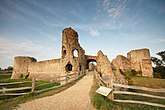Rape of Pevensey
The Rape of Pevensey is one of the rapes, the traditional sub-divisions unique to the historic county of Sussex in England.
| Rape of Pevensey | |
|---|---|
 The keep of Lewes Castle, once the administrative centre of the Rape | |
| Area | |
| • 1821 | 228,930 acres (926.4 km2) |
| • 1831 | 228,930 acres (926.4 km2) |
| Population | |
| • 1821 | 44,830 |
| • 1831 | 49,776 |
| Density | |
| • 1821 | 0.20 inhabitants per acre (49/km2) |
| • 1831 | 0.22 inhabitants per acre (54/km2) |
| History | |
| • Created | 6th to 11th century |
| • Succeeded by | Sussex (eastern division) |
| Status | Rape (county subdivision) |
| • HQ | Pevensey |
| Subdivisions | |
| • Type | Hundreds |
| • Units | Alciston, Bishopstone, Burleigh Arches, Danehill, Horsted, Dill, East Grinstead, Eastbourne, Flexborough, Hartfield, Longbridge, Loxfield Dorset, Loxfield Pelham, Pevensey Lowey, Ringmer, Rotherfield, Rushmonden, Shiplake, Totnore, Willingdon |
History
William the Conqueror granted the rape of Pevensey to his half-brother Robert, Count of Mortain shortly after the Norman Conquest.
Location
Pevensey rape lies between the rape of Lewes to the west and the rape of Hastings to the east. The north-west of the rape is bounded by the county of Surrey and the north-east of the rape by the county of Kent. To the south lies the English Channel. The rape of Pevensey includes the towns of Crowborough, Eastbourne and East Grinstead. At 242 metres (794 ft) tall, Crowborough Beacon in the High Weald is the highest point in the rape.
Sub-divisions
The rape is traditionally divided into the following hundreds:
- Alciston
- Bishopstone
- Burleigh Arches
- Danehill Horsted
- Dill
- East Grinstead
- Eastbourne
- Flexborough
- Hartfield
- Longbridge
- Loxfield Dorset
- Loxfield Pelham
- Pevensey Lowey
- Ringmer
- Rotherfield
- Rushmonden
- Shiplake
- Totnore
- Willingdon